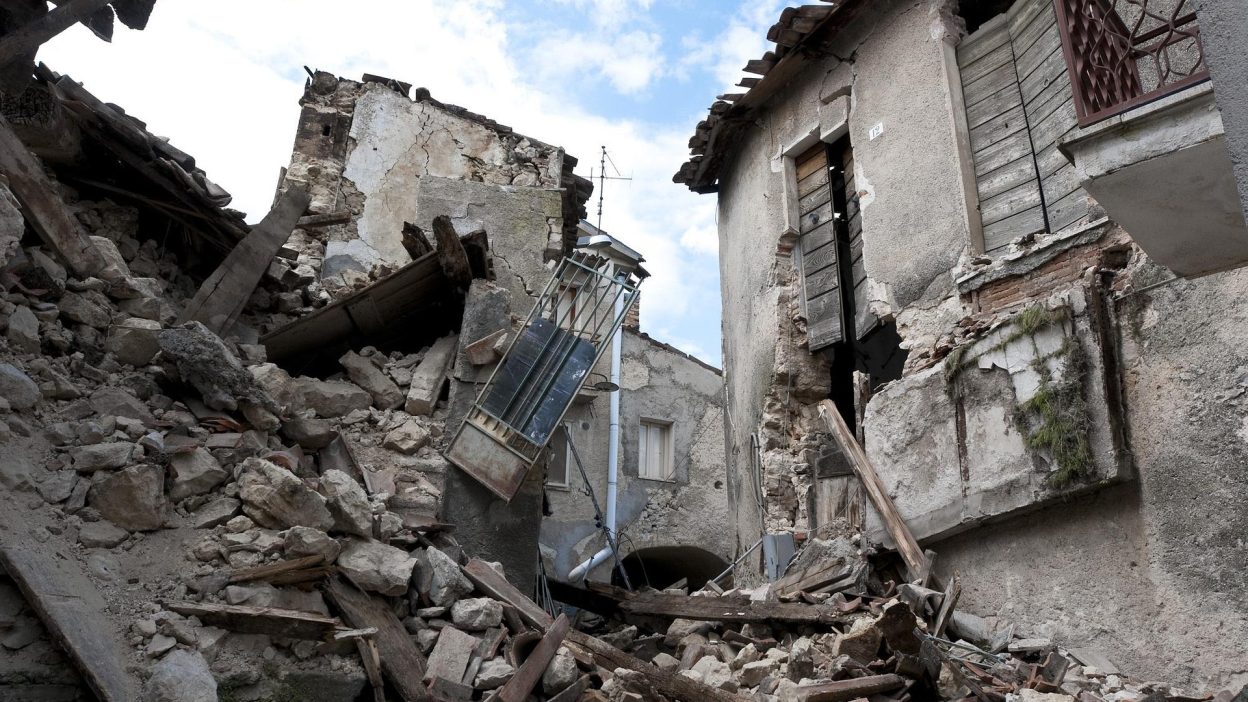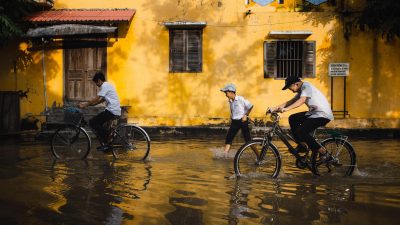When the Earth Shattered a Nation
1. A Morning of Horror: The Deadly Quake Strikes
On 27 May 2006, the Indonesian island of Java was shaken awake by a devastating earthquake measuring 6.3 on the Richter scale. The tremors struck the Yogyakarta Special Region and Central Java, causing buildings to collapse and lives to be lost in mere seconds. The earthquake, occurring at 5:54 AM local time, was shallow, with a depth of just 12 km (7.5 miles), intensifying its impact on the surface.
Residents who had barely started their day suddenly found themselves buried under rubble, desperately seeking safety. Panic spread as aftershocks followed, preventing people from returning to whatever remained of their homes. In a country frequently affected by seismic activity, this quake was particularly catastrophic due to the high population density and weak infrastructure.
2. The Silent Assassin: How the Tectonic Plates Caused Chaos
Indonesia lies on the Pacific Ring of Fire, a region notorious for intense seismic activity due to the movement of multiple tectonic plates. The Indo-Australian Plate subducting beneath the Eurasian Plate is responsible for the frequent earthquakes in the region. In the case of the 2006 Yogyakarta Earthquake, the sudden release of stress along this fault line led to severe shaking.
Unlike deep-focus earthquakes that dissipate energy before reaching the surface, this shallow-focus event had a direct and deadly impact on the region. The type of fault movement played a major role in determining the extent of destruction. The absence of a tsunami was a small relief, but the damage on land was catastrophic.
3. A Nation in Ruins: The Terrifying Death Toll and Destruction
- Deaths and Casualties: More than 5,700 people lost their lives, and over 37,000 were injured. Thousands more were left in critical condition, overwhelming local hospitals.
- Structural Devastation: Nearly 280,000 houses were damaged or destroyed, leaving approximately 1.5 million people homeless. Entire villages were flattened, forcing families to take shelter in makeshift camps.
- Economic Impact: The financial losses were estimated at $3.1 billion, severely affecting the local economy. Many businesses never recovered from the catastrophe.
- Cultural Heritage Loss: Historical sites, including parts of the Prambanan Temple, a UNESCO World Heritage Site, suffered significant damage. Restoration efforts took years.
- Emergency Response Struggles: Immediate medical and rescue assistance was hindered due to destroyed roads and infrastructure, delaying aid to the affected areas.
4. The Human Cost: Survivors’ Stories of Tragedy and Survival
For survivors, the horror of the Yogyakarta Earthquake was a nightmare that unfolded in front of their eyes. Families were torn apart, and thousands lost loved ones in mere seconds. Many survivors recalled how they woke up to their houses shaking violently, only to realise that the walls were coming down around them.
One survivor, Siti Rahma, described how she was trapped under rubble with her young son. “I could hear him crying, but I couldn’t move. The dust was choking us, and I thought we wouldn’t make it,” she recalled. Rescuers eventually pulled them out, but she lost her husband in the collapse.
Many others suffered psychological trauma, haunted by the memories of the devastation. Schools, hospitals, and marketplaces were turned into rubble, and the once-bustling city of Yogyakarta felt like a ghost town.
5. The Government’s Delayed Response: Could More Lives Have Been Saved?
The Indonesian government faced heavy criticism for its slow response to the disaster. Initial rescue efforts were disorganised, and survivors went days without proper aid. The delay in deploying medical teams, food supplies, and temporary shelters caused further suffering.
Several factors contributed to this sluggish response:
- Lack of Preparedness: Despite being in a disaster-prone region, the government’s emergency plans were inadequate.
- Collapsed Infrastructure: Many roads were blocked, making it difficult for rescue teams to reach remote villages.
- Shortage of Resources: Hospitals overflowed with patients, and there weren’t enough medical supplies to treat the injured.
International aid organisations, including the United Nations, stepped in to assist, but the delay in government action led to preventable deaths.
6. International Aid: The Global Response to Indonesia’s Nightmare
As news of the disaster spread, foreign governments and humanitarian organisations quickly mobilised support. Countries such as the United States, Australia, and Japan sent emergency funds, relief materials, and medical teams to assist the victims.
The World Health Organisation (WHO) provided medical aid, while UNICEF focused on helping displaced children. Despite the challenges, the international response was crucial in preventing a secondary disaster—a public health crisis due to poor sanitation and water shortages.
7. The Long Road to Recovery: How Yogyakarta Rebuilt Itself
- Reconstruction Efforts: The Indonesian government launched a multi-billion-dollar recovery programme, prioritising housing and infrastructure repair.
- Foreign Investment: Financial aid from international donors played a critical role in rebuilding hospitals, schools, and public utilities.
- Community Resilience: Locals formed volunteer groups to support their communities, proving that resilience was stronger than tragedy.
- Cultural Revival: Damaged historical sites, such as the Prambanan Temple, underwent restoration to preserve Yogyakarta’s rich heritage.
- Stronger Disaster Preparedness: The disaster led to better earthquake-resistant building codes and improved emergency response mechanisms.
8. The Forgotten Disaster: Why the Yogyakarta Earthquake Faded from Public Memory
Despite its devastating impact, the 2006 Yogyakarta Earthquake has not remained in global memory like other disasters. Unlike the 2004 Indian Ocean Tsunami, which caused a massive international response, this earthquake did not receive the same long-term media coverage.
One reason for this is that the damage was localised. While it caused significant destruction and loss of life, it did not affect multiple countries or lead to a widespread humanitarian crisis beyond Indonesia. Additionally, global attention soon shifted to other disasters, such as the 2008 Sichuan Earthquake in China and the 2010 Haiti Earthquake, both of which had larger international responses.
Another key factor was media focus. The coverage mainly revolved around international aid efforts rather than the human stories of loss and survival. Over time, as Indonesia rebuilt and other global events took centre stage, the Yogyakarta Earthquake faded from public consciousness. Only the survivors and those directly affected continue to carry the memories of that tragic day.
9. Could It Happen Again? The Threat of Future Earthquakes in Indonesia
Indonesia sits on the Pacific Ring of Fire, one of the most active seismic zones in the world. The 2006 Yogyakarta Earthquake was a harsh reminder that Java, one of the country’s most densely populated islands, remains at risk of future seismic disasters.
Scientists and geologists have warned that another major earthquake in Java is not a matter of ‘if’ but ‘when’. The same tectonic forces that caused the 2006 quake are still active, and stress continues to build along fault lines. If a similar shallow-focus earthquake were to strike again, it could result in just as much—if not more—destruction.
The Indonesian government has since strengthened building regulations, enforced better disaster preparedness programs, and installed early warning systems. However, challenges remain, especially in rural areas where many houses are still built using weak materials that cannot withstand powerful tremors. Without further improvements, Java remains dangerously vulnerable to another earthquake of this magnitude.
10. Lessons from Yogyakarta: Preparing for the Next Earthquake
The 2006 Yogyakarta Earthquake provided critical lessons in disaster preparedness and response. The tragedy exposed gaps in infrastructure, slow emergency responses, and the need for stricter safety regulations.
For countries prone to earthquakes, prevention is key. Governments and organisations must invest in:
- Stronger building codes: Many deaths occurred because buildings were not constructed to withstand seismic activity. Enforcing stricter regulations can help reduce casualties in future quakes.
- Faster emergency response systems: Delays in aid distribution and medical treatment cost lives in 2006. Having a well-organised disaster response team can make a significant difference.
- Public awareness and education: Many people do not know how to react during an earthquake. Teaching communities about earthquake drills and safety measures can help reduce panic and save lives.
The next major earthquake is inevitable, but how prepared we are will determine how many lives are saved. Learning from the past ensures that tragedies like Yogyakarta 2006 are not repeated on the same scale.
Frequently Asked Questions (FAQs)
1. How strong was the Yogyakarta Earthquake?
The earthquake had a magnitude of 6.3 and struck Java’s Yogyakarta region at a shallow depth of 12 km (7.5 miles).
2. How many people died in the earthquake?
Over 5,700 people were killed, and more than 37,000 were injured. The death toll was high due to collapsed buildings and lack of immediate medical assistance.
3. Why was the earthquake so destructive?
The shallow depth, weak infrastructure, and high population density contributed to the massive destruction. Many homes and buildings were not earthquake-resistant, leading to widespread collapse.
4. Did the earthquake trigger a tsunami?
No, the earthquake originated on land, not underwater, so it did not generate a tsunami. However, strong aftershocks caused further destruction.5. How long did recovery efforts take?
Full recovery took several years. Many homes, businesses, and historical sites like Prambanan Temple required extensive repairs. Some communities never fully recovered from the economic impact.




